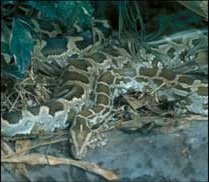
The Indian Python is a highly arboreal snake, once fairly common throughout India. They live in a wide range of habitats, but are dependent on a continuous water supply.
Growing to a length of about 20 feet (6 m) and weighing in at 120 pounds (32-55 kg) they belong to the Boidae family of snakes, which contain the worlds largest snake species also including boas and anacondas.
In the wild Indian Pythons, who have a life span of about 20-30 years, live predominantly on mammals and birds.
Although large, Indian Pythons spend most of their time on the ground but are skilful at climbing and moving through trees, and are very good swimmers. Their dramatic skin pigmentation of intricate earth tones patterns enables Pythons to blend in with their natural setting.
A hungry Python will lie in ambush, patiently waiting for suitable prey to pass. It is a constrictor, a snake that kills its prey by squeezing. Mammals are preferred prey, but Pythons will also eat bird and even fish.
Indian Pythons become sexually mature at about 3 years of age. The female, who is a devoted mother, lays around 20-60 eggs in a single clutch with the young snakes leaving the nest soon after hatching.
No comments:
Post a Comment